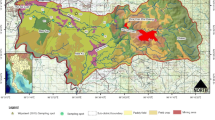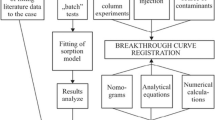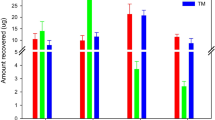Abstract
Background, aim and scope
Chlormequat (Cq) is a plant growth regulator used throughout the world. Despite indications of possible effects of Cq on mammalian health and fertility, little is known about its fate and transport in subsurface environments. The aim of this study was to determine the fate of Cq in three Danish subsurface environments, in particular with respect to retardation of Cq in the A and B horizons and the risk of leaching to the aquatic environment. The study combines laboratory fate studies of Cq sorption and dissipation with field scale monitoring of the concentration of Cq in the subsurface environment, including artificial drains.
Materials and methods
For the laboratory studies, soil was sampled from the A and B horizons at three Danish field research stations—two clayey till sites and one coarse sandy site. Adsorption and desorption were described by means of the distribution coefficient (K d) and the Freundlich adsorption coefficient (K F,ads). The dissipation rate was estimated using soil sampled from the A horizon at the three sites. Half life (DT50) was calculated by approximation to first-order kinetics. A total of 282 water samples were collected at the sites under the field monitoring study— groundwater from shallow monitoring screens located 1.5–4.5 m b.g.s. at all three sites as well as drainage water from the two clayey sites and porewater from suction cups at the sandy site, in both cases from 1 m b.g.s. The samples were analysed using LC-MS/MS. The field monitoring study was supported by hydrological modelling, which provided an overall water balance and a description of soil water dynamics in the vadose zone.
Results
The DT50 of Cq from the A horizon ranged from 21 to 61 days. The Cq concentration-dependant distribution coefficient (K d) ranged from 2 to 566 cm3/g (median 18 cm3/g), and was lowest in the sandy soil (both the A and B horizons). The K F,ads ranged from 3 to 23 (µg1 − 1/n (cm3)1/n g−1) with the exponent (1/n) ranging from 0.44 to 0.87, and was lowest in the soil from the sandy site. Desorption of Cq was very low for the soil types investigated (<10%w). Cq in concentrations exceeding the detection limit (0.01 µg/L) was only found in two of the 282 water samples, the highest concentration being 0.017 µg/L.
Discussion
That sorption was highest in the clayey till soils is attributable to the composition of the soil, the soil clay and iron content being the main determinant of Cq sorption in both the A and B horizons of the subsurface environment. Cq was not detected in concentrations exceeding the detection limit in either the groundwater or the porewater at the sandy site. The only two samples in which Cq was detected were drainage water samples from the two clayey till sites. The presence of Cq here was probably attributable to the hydrogeological setting as water flow at the two clayey till sites is dominated by macropore flow and less by the flow in the low permeability matrix. In contrast, water flow at the sandy site is dominated by matrix flow in the high permeability matrix, with negligible macropore flow. Given the characteristics of these field sites, Cq adsorption and desorption can be expected to be controlled by the clay composition and content and the iron content. Combining these observations with the findings of the sorption and dissipation studies indicates that the key determinant of Cq retardation and fate in the soil is sorption characteristics and bioavailability.
Conclusions
The leaching risk of Cq was negligible at the clayey till and sandy sites investigated. The adsorption and desorption experiments indicated that absorption of Cq was high at all three sites, in particular at the clayey till sites, and that desorption was generally very limited. The study indicates that leaching of Cq to the groundwater is hindered by sorption and dissipation. The detection of Cq in drainage water at the clayey till sites and the evidence for rapid transport through macropores indicate that heavy precipitation events may cause pulses of Cq.
Recommendations and perspectives
The present study is the first to indicate that the risk of Cq leaching to the groundwater and surface water is low. Prior to any generalisation of the present results, the fate of Cq needs to be studied in other soil types, application regimes and climatic conditions to determine the Cq retardation capacity of the soils. The study identifies bioavailability and heavy precipitation events as important factors when assessing the risk of Cq contamination of the aquatic environment. The possible effects of future climate change need to be considered when assessing whether or not Cq poses an environmental risk.



Similar content being viewed by others
References
Alder L, Startin JR (2005) Determination of chlormequat and mepiquat in foods by liquid chromatography/mass spectrometry or liquid chromatography/tandem mass spectrometry: interlaboratory study. J AOAC Int 88:1762–1776
Alexopoulos AA, Akoumianakis KA, Passam HC (2006) Effect of plant growth regulators on the tuberisation and physiological age of potato (Solanum tuberosum L.) tubers grown from true potato seed. Can J Plant Sci 86:1217–1225
Andersen HR, Vinggaard AM, Rasmussen TH, Gjermandsen IM, Bonefeld-Jorgensen EC (2002) Effects of currently used pesticides in assays for estrogenicity, androgenicity, and aromatase activity in vitro. Toxicol Appl Pharmacol 179:1–12
Andersen JH, Bille RLL, Granby K (2007) An intercomparison study of the determination of glyphosate, chlormequat and mepiquat residues in wheat. Food Addit Contam 24:140–148
Anonymous (1999a) The pesticide manual, 11th edn. British Crop Protection Council, Surrey
Anonymous (1999b) Soil taxonomy—a basic system of soil classification for making and interpreting soil surveys, 2nd edn. USDA-NRCS Agricultural Handbook, vol 436. United States Department of Agriculture, New York
Anonymous (2000) Adsorption-desorption using a batch equilibrium method. Section 1: physical chemical properties, 106, OECD guideline for the testing of chemicals. OECD, Paris
Anonymous (2006) Reregistration eligibility decision for aliphatic alkyl quaternaries (DDAC). EPA-HQ-OPP-2006-0338/EPA 739-R-06-008. US Environmental Protection Agency, Prevention, Pesticides and Toxic Substances, Washington, D.C.
Anonymous (2007a) The use of plant protection products in the European Union, data 1992-2003. Nadin, Pierre. http://epp.eurostat.ec.europa.eu. ISBN 92-79-03890-7. Eurostat, European Communities, Luxembourg
Anonymous (2007b) Reregistration eligibility decision for chlormequat chloride (RED). EPA-HQ-OPP-2007-0968/EPA 738-R-07-014. US Environmental Protection Agency, Prevention, Pesticides and Toxic Substances, Washington, D.C.
Aramendia MA, Borau V, Lafont F, Marinas A, Marinas JM, Moreno JM, Urbano FJ (2007) Determination of herbicide residues in olive oil by gas chromatography–tandem mass spectrometry. Food Chem 105:855–861
Barbash JE (2007) The geochemistry of pesticides 9.15. In: Holland HD, Turekian KK (eds) Treatise on geochemistry. Oxford, Pergamon, pp 1–43
Barlebo HC, Rosenbom AE, and Kjaer J (2007) Evaluation of pesticide scenarios for the registration procedure. Environmental Project No. 1178, Danish Environmental Protection Agency, Copenhagen
Berry PM, Sterling M, Spink JH, Baker CJ, Sylvester-Bradley R, Mooney SJ, Tams AR, Ennos AR (2004) Understanding and reducing lodging in cereals. Adv Agron Vol 84(84):217–271
Bethke CM, Brady PV (2000) How the Kd approach undermines ground water cleanup. Ground Water 38:435–443
Beulke S, Brown CD (2001) Evaluation of methods to derive pesticide degradation parameters for regulatory modelling. Biol Fert Soils 33:558–564
Browne RA, White EM, Burke JI (2006) Responses of developmental yield formation processes in oats to variety, nitrogen, seed rate and plant growth regulator and their relationship to quality. J Agr Sci 144:533–545
de Jonge LW, Kjaergaard C, Moldrup P (2004) Colloids and colloid-facilitated transport of contaminants in soils: an introduction. Vadose Zone J 3:321–325
Dekhuijz HM, Vonk CR (1974) Distribution and degradation of chlormequat in wheat plants. Pestic Biochem Physiol 4:346–355
Esparza X, Moyano E, Galceran MT (2009) Analysis of chlormequat and mepiquat by hydrophilic interaction chromatography coupled to tandem mass spectrometry in food samples. J Chromatogr A 1216:4402–4406
Espindula MC, Rocha VS, Grossi JAS, Souza MA, Souza LT, Favarato LF (2009) Use of growth retardants in wheat. Planta Daninha 27:379–387
Fairbrother A, Yuill TM, Olson LJ (1986) Effects of three plant growth regulators on the immune-response of young and aged deer mice Peromyscus Maniculatus. Arch Environ Contam Toxicol 15:265–275
Flury M (1996) Experimental evidence of transport of pesticides through field soils—a review. J Environ Qual 25:25–45
Gencsoylu I (2009) Effect of plant growth regulators on agronomic characteristics, lint quality, pests, and predators in cotton. J Plant Growth Regul 28:147–153
Gevao B, Semple KT, Jones KC (2000) Bound pesticide residues in soils: a review. Environ Pollut 108:3–14
Giles CH, MacEwan TH, Nakhwa SN, Smith D (1960) Studies in adsorption. Part XI. A system of classification of solution adsorption isotherms, and its use in diagnosis of adsorption mechanisms and in measurement of specific surface areas of soil. J Chem Soc 4:3973–3993
Gocer M, Hoferer K, Zipfel J, Spangenberg B (2009) A new TLC method for quantification of paraquat, diquat, difenzoquat, mepiquat and chloromequat in water. J Planar Chromatogr—Mod TLC 22:59–63
Granby K, Vahl M (2001) Investigation of the herbicide glyphosate and the plant growth regulators chlormequat and mepiquat in cereals produced in Denmark. Food Addit Contam 18:898–905
Hauptman S, Bier H, Faust H (1969) Chemistry of 2-chloroethyltrimethyl ammonium chloride (in German). J Prakt Chem 311:705–711
Henriksen T, Juhler RK, Brandt G, Kjaer J (2009) Analysis of the plant growth regulator chlormequat in soil and water using liquid chromatography tandem mass-spectrometry (LC-MS/MS), pressurised liquid extraction, and solid phase extraction. J Chromatogr A 1216:2504–2510
Hughes RG (1967) Chlormequat to control lodging in wheat. Agriculture 74:133
Jarvis NJ (2007) A review of non-equilibrium water flow and solute transport in soil macropores: principles, controlling factors and consequences for water quality. Eur J Soil Science 58:523–546
Jin F, Hu HY, Yang M, Jin XH, He WJ, Han HD (2006) Determination of diallyldimethylammonium chloride in drinking water by reversed-phase ion-pair chromatography-electrospray ionization mass spectrometry. J Chromatogr A 1101:222–225
Juhler RK, Henriksen TH, Ernstsen V, Vinther FP, Rosenberg P (2008) Impact of basic soil parameters on pesticide disappearance investigated by multivariate partial least square regression and statistics. J Environ Qual 37:1719–1732
Juhler RK, Vahl M (1999) Residues of chlormequat and mepiquat in grain—results from the Danish National Pesticide Survey. J AOAC Int 82:331–336
Kamel AH, Moreira FTC, Almeida SAA, Sales MGF (2008) Novel potentiometric sensors of molecular imprinted polymers for specific binding of chlormequat. Electroanalysis 20:194–202
Kjaer J, Olsen P, Bach K, Barlebo HC, Ingerslev F, Hansen M, Sorensen BH (2007) Leaching of estrogenic hormones from manure-treated structured soils. Environ Sci Technol 41:3911–3917
Kjaer J, Olsen P, Ullum M, Grant R (2005) Leaching of glyphosate and amino-methylphosphonic acid from Danish agricultural field sites. J Environ Qual 34:608–620
Kookana RS, Aylmore LAG (1993) Retention and release of diquat and paraquat herbicides in soils. Aust J Soil Res 31:97–109
Kramers PGN, Knaap AGAC, Voogd CE (1975) Lack of mutagenicity of chlormequat chloride in Drosophila and in bacteria. Mutat Res 31:65–68
Langhammer M, Kuhla S, Schneider F, Renne U, Spitschak M, Hagemeister H (1999) Effects of chlorocholine chloride-treated wheat on special fertility traits in laboratory mice. J Anim Physiol An N 81:190–202
Larsbo M, Roulier S, Stenemo F, Kasteel R, Jarvis N (2005) An improved dual-permeability model of water flow and solute transport in the vadose zone. Vadose Zone J 4:398–406
Leffers H, Hansen M, Sorensen MT, Guillette L, Tuomisto J, Jensen AA, Bjerregaard P (2006) Effects of the plant growth regulator, chlormequat, on mammalian fertility—discussion. Int J Androl 29:129–133
Leitch MH, Kurt O (1999) Effects of plant growth regulators on stem extension and yield components of linseed (Linum usitatissimum). J Agr Sci 132:189–199
Lesueur C, Gartner M, Mentler A, Fuerhacker M (2007) Qualitative and quantitative analysis of polar pesticide multiresidues in leaf samples with a liquid chromatography-ion-trap mass-selective detector. Int J Environ Anal Chem 87:1013–1032
Lindhardt B, Abiltrup C, Vosgerau H, Olsen P, Torp S, Iversen BV, Jørgensen OJ, Plauborg F, Rasmussen P, Gravesen P (2001) The Danish Pesticide Leaching Assessment Programme, Site characterization and monitoring design. Geological Survey of Denmark and Greenland, GEUS, Copenhagen
Liu L, Tindall JA, Friedel MJ, Zhang WX (2007) Biodegradation of organic chemicals in soil/water microcosms system: model development. Wat Air Soil Poll 178:131–143
Lopez-Paz JL, Catala-Icardo M, Anton-Garrido B (2009) Determination of diquat by flow injection–chemiluminescence. Anal Bioanal Chem 394:1073–1079
Marchese S, Perret D, Bafile E, Gentili A, Caretti F, Berardino M (2009) Pressurized liquid extraction coupled with LC-ESI-MS-MS for the determination of herbicides chlormequat and mepiquat in flours. Chromatographia 70:761–767
Maqueda C, Morillo E (2001) Sorption of chlormequat on montmorillonite as affected by dissolved copper. Influence of background electrolytes. Clay Miner 36:473–481
Maza J, Jimenezlopez A, Bruque S (1989) Interaction of chlorocholine chloride with montmorillonite. Soil Sci 147:11–16
McKeague JA, Day JH (1966) Dithionite- and oxalate-extractable Fe and Al as aids in differentiating various classes of soils. Can J Soil Sci 46:13–22
Nurhayati CS, Chaidir ERA, Ebel R, ter Meulen U (2006) The metabolite products of chlorocholine chloride (CCC) in eggs and meat of laying hens fed N-15-CCC containing diets. J Anim Physiol Anim Nutr 90:165–172
Olson LJ, Hinsdill RD (1984) Influence of feeding chlorocholine chloride and glyphosine on selected immune parameters in deer mice, Peromyscus maniculatus. Toxicology 30:103–114
Pateiro-Moure M, Martinez-Carballo E, Arias-Estevez M, Simal-Gandara J (2008) Determination of quaternary ammonium herbicides in soils—comparison of digestion, shaking and microwave-assisted extractions. J Chromatogr A 1196:110–116
Pateiro-Moure M, Perez-Novo C, Arias-Estevez M, Rial-Otero R, Simal-Gandara J (2009) Effect of organic matter and iron oxides on quaternary herbicide sorption–desorption in vineyard-devoted soils. J Colloid Interface Sci 333:431–438
Pico Y, Font G, Ruiz MJ, Fernandez M (2006) Control of pesticide residues by liquid chromatography–mass spectrometry to ensure food safety. Mass Spectrom Rev 25:917–960
Poulsen ME, Christensen HB, Sorensen MT, Leffers H, Andersen JH (2007) Determination of chlormequat in pig serum and sow milk by LC-MS/MS. Anal Bioanal Chem 389:1799–1804
Rademacher W (2000) Growth retardants: effects on gibberellin biosynthesis and other metabolic pathways. Annu Rev Plant Phys 51:501–531
Reardon EJ (1981) Kd’s—can they be used to describe reversible ion sorption reactions in contaminant migration. Ground Water 19:279–286
Reynolds SL, Hill ARC, Thomas MR, Hamey PY (2004) Occurrence and risks associated with chlormequat residues in a range of foodstuffs in the UK. Food Addit Contam 21:457–471
Rhodes D, Hanson AD (1993) Quaternary ammonium and tertiary sulfonium compounds in higher plants. Annu Rev Plant Phys 44:357–384
Rosenbom AE, Ernstsen V, Fluhler H, Jensen KH, Refsgaard JC, Wydler H (2008) Fluorescence imaging applied to tracer distributions in variably saturated fractured clayey till. J Environ Qual 37:448–458
Rytwo G, Tropp D (2001) Improved efficiency of a divalent herbicide in the presence of clay, by addition of monovalent organocations. Appl Clay Sci 18:327–333
Rytwo G, Tropp D, Serban C (2002) Adsorption of diquat, paraquat and methyl green on sepiolite: experimental results and model calculations. Appl Clay Sci 20:273–282
Smith MC, Shaw DR, Massey JH, Boyette M, Kingery W (2003) Using nonequilibrium thin-disc and batch equilibrium techniques to evaluate herbicide sorption. J Environ Qual 32:1393–1404
Sorensen MT, Danielsen V (2006) Effects of the plant growth regulator, chlormequat, on mammalian fertility. Int J Androl 29:129–132
Sorensen MT, Poulsen ME, Leffers H, Vajta G, Halekoh U (2009) No effect of the plant growth regulator, chlormequat, on boar fertility. Animal 3:697–702
Stenrod M, Heggen HE, Bolli RI, Eklo OM (2008) Testing and comparison of three pesticide risk indicator models under Norwegian conditions—a case study in the Skuterud and Heiabekken catchments. Agr Ecosyst Environ 123:15–29
Sussmuth R, Lingens F (1976) Mutagenic actions of chlorocholine chloride. Mutat Res 40:229–235
Tolbert NE (1960) (2-Chloroethyl)trimethylammonium chloride and related compounds as plant growth substances. II. Effect on growth of wheat. Plant Physiol 35:380–385
Torner H, Blottner S, Kuhla S, Langhammer M, Alm H, Tuchscherer A (1999) Influence of chlorocholinechloride-treated wheat on selected in vitro fertility parameters in male mice. Reprod Toxicol 13:399–404
Ueberschar KH, Danicke S, Wolff J (2003) Gaschromatic determination of chlormequat in silo cereals and bran. Landbauforsch Volk 53:37–42
Vahl M, Graven A, Juhler RK (1998) Analysis of chlormequat residues in grain using liquid-chromatography mass–spectrometry (LC-MS/MS). Fresenius J Anal Chem Vol 361: 817–820
Wang JH, Lu XY, Huang M, Wu Z, Ma GP, Xu CY (2007) Rapid screening and confirmation of chlormequat and mepiquat residues in tomato and its products using liquid chromatography with electrospray tandem mass spectrometry. Chin J Anal Chem 35:1509–1512
Yamano T, Morita S (1993) Effects of pesticides on isolated rat hepatocytes, mitochondria, and microsomes. Arch Environ Contam Toxicol 25:271–278
Zhang WX, Bouwer EJ, Ball WP (1998) Bioavailability of hydrophobic organic contaminants: effects and implications of sorption-related mass transfer on bioremediation. Ground Water Monit Remediat 18:126–138
Zhao Y, Lazou K, Schelfaut M, De Reu L, Sandra P (2000) Determination of chlormequat residues in pears and pear concentrates by benchtop LC-ESI-MS. Chromatographia 51:531–535
Acknowledgements
The project was supported financially by Copenhagen Energy (Københavns Energi A/S). We wish to thank P. Stockmarr (GEUS) for skilled technical assistance in connection with method development and sample analysis, P. Olsen (Aarhus University), L. Gudmundsson (GEUS), C. Andersen (Jyndevad Research Station), P. Boesen (Estrup Research Station) and J. Molbo (Silstrup Research Station) for assistance with the field leaching experiments, and D. I. Barry for linguistic assistance.
Author information
Authors and Affiliations
Corresponding author
Additional information
Communicated by Henner Hollert
Rights and permissions
About this article
Cite this article
Juhler, R.K., Henriksen, T., Rosenbom, A.E. et al. Fate and transport of chlormequat in subsurface environments. Environ Sci Pollut Res 17, 1245–1256 (2010). https://doi.org/10.1007/s11356-010-0303-5
Received:
Accepted:
Published:
Issue Date:
DOI: https://doi.org/10.1007/s11356-010-0303-5




